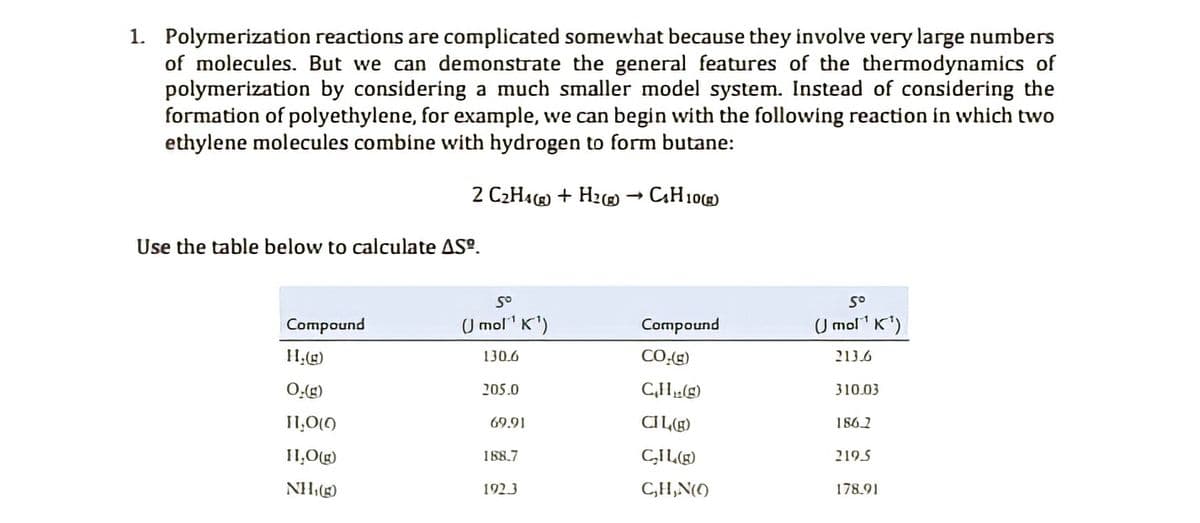1. Polymerization reactions are complicated somewhat because they involve very large numbers of molecules. But we can demonstrate the general features of the thermodynamics of polymerization by considering a much smaller model system. Instead of considering the formation of polyethylene, for example, we can begin with the following reaction in which two ethylene molecules combine with hydrogen to form butane: 2 C2H4) + H2( - GH10) Use the table below to calculate ASº. Compound U mol" K) Compound (J mol K') 130.6 CO:(g) 213.6 205.0 C,H„(g) 310.03 I1,0() 69.91 CIL() 186.2 188.7 CIL® 219.5 NH) 1923 C,H,N(O 178.91
1. Polymerization reactions are complicated somewhat because they involve very large numbers of molecules. But we can demonstrate the general features of the thermodynamics of polymerization by considering a much smaller model system. Instead of considering the formation of polyethylene, for example, we can begin with the following reaction in which two ethylene molecules combine with hydrogen to form butane: 2 C2H4) + H2( - GH10) Use the table below to calculate ASº. Compound U mol" K) Compound (J mol K') 130.6 CO:(g) 213.6 205.0 C,H„(g) 310.03 I1,0() 69.91 CIL() 186.2 188.7 CIL® 219.5 NH) 1923 C,H,N(O 178.91
Chemistry: Principles and Reactions
8th Edition
ISBN:9781305079373
Author:William L. Masterton, Cecile N. Hurley
Publisher:William L. Masterton, Cecile N. Hurley
Chapter23: Organic Polymers, Natural And Synthetic
Section: Chapter Questions
Problem 48QAP
Related questions
Question

Transcribed Image Text:1. Polymerization reactions are complicated somewhat because they involve very large numbers
of molecules. But we can demonstrate the general features of the thermodynamics of
polymerization by considering a much smaller model system. Instead of considering the
formation of polyethylene, for example, we can begin with the following reaction in which two
ethylene molecules combine with hydrogen to form butane:
2 C2H4 + H2g → GH10)
Use the table below to calculate ASº.
Compound
(J mol" K')
Compound
U mol" K')
130.6
CO:(g)
213.6
O:(g)
205.0
C,H(g)
310.03
II,O()
CI L(g)
69.91
186.2
I1,0(g)
188.7
CIL(E)
219.5
NH(g)
1923
C,H,N(O
178.91
Expert Solution
This question has been solved!
Explore an expertly crafted, step-by-step solution for a thorough understanding of key concepts.
Step by step
Solved in 2 steps

Knowledge Booster
Learn more about
Need a deep-dive on the concept behind this application? Look no further. Learn more about this topic, chemistry and related others by exploring similar questions and additional content below.Recommended textbooks for you

Chemistry: Principles and Reactions
Chemistry
ISBN:
9781305079373
Author:
William L. Masterton, Cecile N. Hurley
Publisher:
Cengage Learning

Principles of Modern Chemistry
Chemistry
ISBN:
9781305079113
Author:
David W. Oxtoby, H. Pat Gillis, Laurie J. Butler
Publisher:
Cengage Learning

Chemistry & Chemical Reactivity
Chemistry
ISBN:
9781337399074
Author:
John C. Kotz, Paul M. Treichel, John Townsend, David Treichel
Publisher:
Cengage Learning

Chemistry: Principles and Reactions
Chemistry
ISBN:
9781305079373
Author:
William L. Masterton, Cecile N. Hurley
Publisher:
Cengage Learning

Principles of Modern Chemistry
Chemistry
ISBN:
9781305079113
Author:
David W. Oxtoby, H. Pat Gillis, Laurie J. Butler
Publisher:
Cengage Learning

Chemistry & Chemical Reactivity
Chemistry
ISBN:
9781337399074
Author:
John C. Kotz, Paul M. Treichel, John Townsend, David Treichel
Publisher:
Cengage Learning

Chemistry & Chemical Reactivity
Chemistry
ISBN:
9781133949640
Author:
John C. Kotz, Paul M. Treichel, John Townsend, David Treichel
Publisher:
Cengage Learning

Chemistry: The Molecular Science
Chemistry
ISBN:
9781285199047
Author:
John W. Moore, Conrad L. Stanitski
Publisher:
Cengage Learning

Introductory Chemistry: An Active Learning Approa…
Chemistry
ISBN:
9781305079250
Author:
Mark S. Cracolice, Ed Peters
Publisher:
Cengage Learning